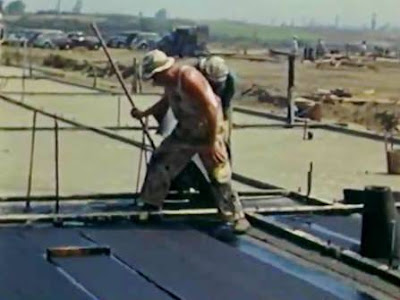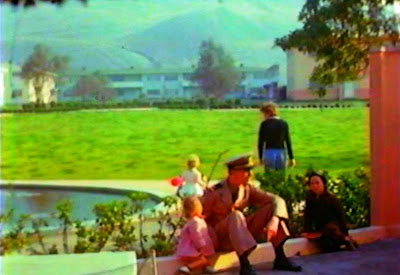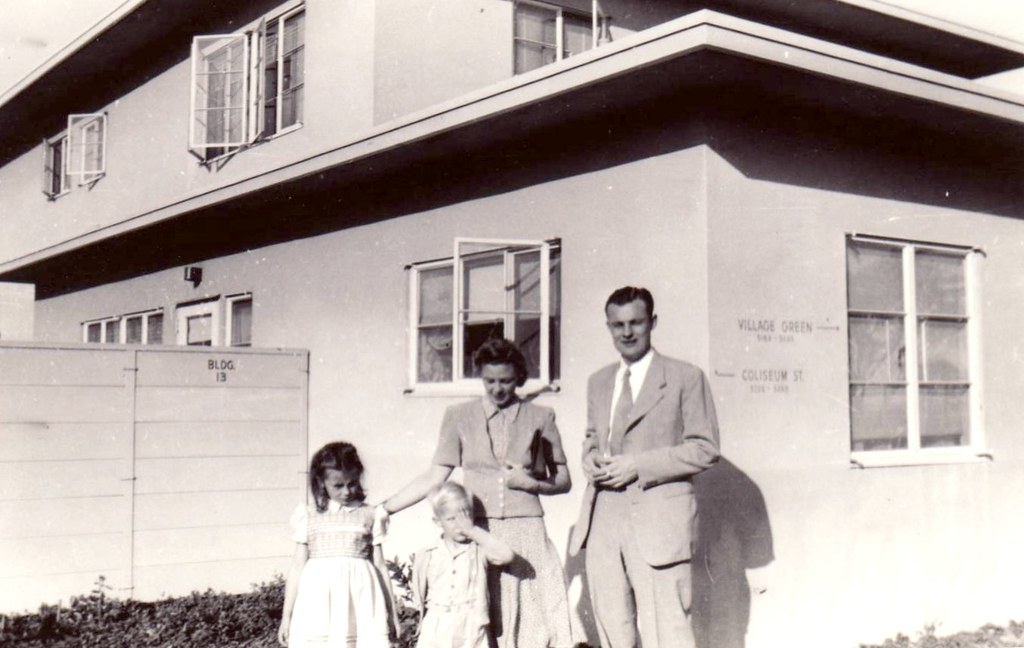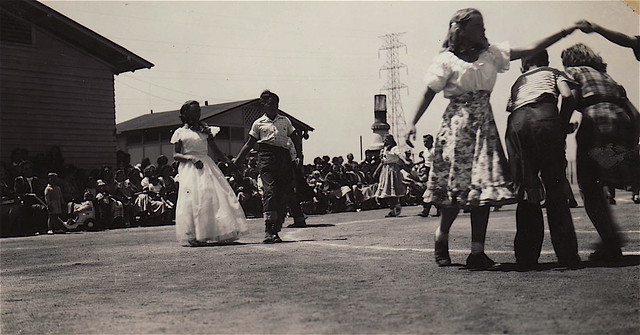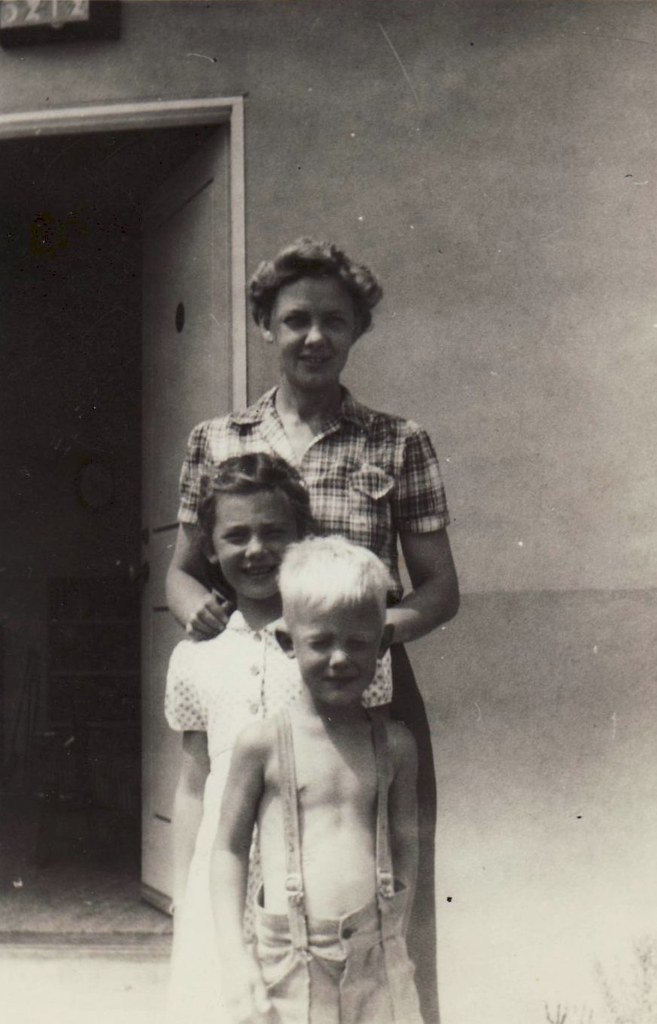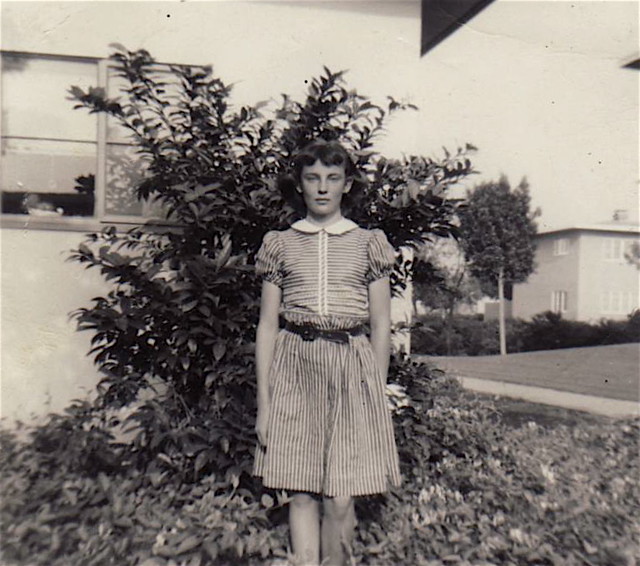As those of you who live at the Village Green probably know, for the last year or so a group of residents has been exploring the idea of restoring a play area to the Village Green. Playgrounds and other recreational features were originally provided when the Village opened in late 1941. These areas set aside for recreation were considered vital to the overall success by the design team responsible for Baldwin Hills Village. Over the years, nearly all of these recreational facilities were removed, usually to provide more parking for automobiles.
As part of the Playground Committee's report, I wrote the following document which describes the planned areas for recreation as designed by the architects and landscape architect.
All photographs are stills from Reginald D. Johnson's 16mm Kodachrome film, which he took in 1944. Photos courtesy of David LeBrun and Night Fire Films.
There are two Town Hall meetings scheduled this week, please try to attend one of them:
Thursday, March 24, 2011
In the Clubhouse, 7:00 p.m.
Saturday, March 26, 2011
In the Clubhouse, 10:00 a.m.
Presentation of current findings of the committee, followed by Q&A. Results of this discussion will be included in the final Proposed Playground Report.
INTRODUCTION:
When Reginald Johnson, in partnership with associated architects Robert Alexander, Lewis Wilson and Edwin Merrill, and Landscape Architect Fred Barlow, Jr, was designing Baldwin Hills Village, great care and attention went into every element. Clarence Stein, the consulting architect, in his book Toward New Towns for America wrote: "The purpose of Baldwin Hills Village was to demonstrate the practical possibilities of spacious homes and surroundings in an orderly community at low rentals, using the basic features of the Radburn Idea: superblock, homes facing central greens—twenty acres of green parks—pedestrian and auto completely separated." Lewis Mumford, introducing Baldwin Hills Village in the September 1944 issue of Pencil Points magazine, noted the community was “one of a handful of projects that stands out as a fundamental advance in both planning and architecture. I know no other recent community that lends itself so fully to strict scrutiny, simply because every aspect of its physical development has been thought through”. Catherine Bauer, in the same issue of Pencil Points, argued that “Baldwin Hills Village is probably the most seriously progressive experiment in home building by private enterprise since Radburn, New Jersey, was started eighteen years ago.”
In addition to all of the attention to planning the layout, architecture, landscape, circulation, and other aspects of the Village, the architects made sure to include a wide variety of recreational features to foster community. The inclusion of several play areas for children was an integral and important element of that design.
After the Village was sold to the New England Mutual Life Insurance Company of Boston in 1949, the Insurance Company began to remove most of the planned recreational features, and began discouraging children (through attrition). When, from 1973 through 1978, Baldwin Hills Village was converted into condominiums and renamed Village Green, it was promoted as an Adults Only community. Only after a California Supreme Court ruling overturned this were children once again permitted at the Village Green.
This document will examine how the original architect’s progressive vision included many recreational amenities to benefit the community, including several areas specifically for children. It will also describe the changes that gradually took place, most of which destroyed or diminished that progressive vision.
The periods that will be discussed are:
- 1941 – 1949 – Baldwin Hills Village Opens; the War Years and early Post-War Years
- 1949 – 1983 – Sale of Baldwin Hills Village; the Condo Conversion; Supreme Court Ruling
- 1983 – Present – Children Again at Village Green
1941 – 1949 – Baldwin Hills Village Opens; The War Years; Early Post-War Period
When Baldwin Hills Village opened in late 1941, it was the end of the Great Depression, and the beginning of World War II.
It was during this time of economic adversity, social reform, technological innovation, and idealized urban planning that Baldwin Hills Village was conceived, designed and built, from 1935-1942.
A new way of living was introduced at Baldwin Hills Village, and the brochure announcing its opening promised all the advantages of private homeownership, with all the services and amenities of a luxury hotel. The brochure also describes “nine play yards” for children.
Soon after Baldwin Hills Village opened, on December 7, 1941, all of the West Coast architects (Reginald Johnson, Robert Alexander, Lewis Wilson and Edwin Merrill), in addition to landscape architect Fred Barlow, Jr., moved into the Village with their families. They wanted to experience first-hand the results of their long planned social experiment: to see how it worked to foster community - and how it might be improved. Reginald Johnson stayed a little over two years; the others stayed for much longer periods of time - Fred Barlow, Jr lived in the Village until 1948, Robert Alexander until 1951; and Lewis Wilson and Edwin Merrill lived in the Village until their deaths, in 1957 and 1964.
PLANNED RECREATIONAL FEATURES
In planning the design of this Utopian new community, much thought went into providing the residents of this “Village within the city” some of the qualities and advantages typical of life in a more rural setting.
Lead architect Reginald D. Johnson, writing in 1943 about the vision and concept behind the creation of Baldwin Hills Village, explained that while cities afforded access to culture, shopping and education, “the lack of opportunity in our cities for normal co-operative recreation for both adults and children is shown by the endless lines of automobiles and crowded trolley cars on week-ends and holidays. This great movement of the people is largely motivated by a desire to escape their environment. The truth is that no one stays home in the modern city unless he has to! This not only results in unnecessary drain on the family purse, but also a most unfortunate drain on the nervous system of both adults and children.”
One of the objectives of Baldwin Hills Village was to “tame the automobile”. Johnson wrote that “Housing, in the modern connotation of the word, represents an effort to solve the problem of city living. The city is not the farm. As to our children, we are finding protection from automobile traffic and a certain degree of supervised play not only desirable but necessary.”
 |
| This site plan illustration of Baldwin Hills Village, showing the areas planned for recreation, as installed in 1941-42. Prepared by Mike McGowan and the Ad Hoc Playground Committee |
To address these issues, the architects included a variety of recreational facilities for the use of the residents at Baldwin Hills Village. These facilities included:
- Clubhouse – Including a lending library, ping-pong tables, darkroom, reading lounge with fireplace, patio, large area used for dances, church services, meetings
- Playground – a large playground near the Clubhouse building
- Tot Lots (smaller fenced play areas) in areas reserved for families with children–– Courts 1, 3, 12 and 17
- Badminton Courts, in areas reserved for adults- Courts 6, 8, 9, 11 (in addition to two adjacent to areas near the Clubhouse - East Circle and West Circle)
- Horseshoe Pits – Courts 9, 11 and 16
- Tennis Courts – either side of the Administration Building, East and West Circle
- Croquet Courts – adjacent to (and south of) Tennis Courts in East and West Circle
- Wading Pool – just south of the Clubhouse
- Putting Greens
 |
| The north entrance to the Clubhouse. |
CLUBHOUSE
During World War Two, when people were unable to leave the Village easily due to gas rationing—regular dances, debates, church gatherings, etc. kept the Clubhouse busy. The Clubhouse also had a library, darkroom, billiards, shuffleboard and ping-pong tables.
 |
| Billiards in the Clubhouse |
 |
| Ping Pong on the patio overlooking the Main Green |
Adjacent to the Clubhouse building, in a large triangular space, was a playground, with a badminton court attached. This playground, because of its proximity to the nursery school, was reserved for children enrolled in the school during WW2 and immediately thereafter. According to a 1943 Baldwin Hills Village newsletter, this play centre was run by Mrs. Catherine McDonald, who watched children aged 2 to 10 by the hour or day. During the war, the Lanham Act provided funds for the creation and running of such nursery schools, to accommodate children whose parents were busy with war work. After the War, many of these schools were privatized. In 1946, the Villager announced “our private Village Nursery School, owned and directed by Mrs. Catherine McDonald, will open its doors to begin receiving the children on the waiting list. The building has been freshly painted, and new, scientific play material is being added as it is made available on the market”.
 |
| The Playground |
The identical triangular area (with attached badminton court) to the west of the Clubhouse was intended as one of a number of planned outdoor gathering spaces (see description in Green Spaces and Outdoor Rooms). An aerial photograph from 1944 shows this space open, but by 1948 it is being used as a plant nursery.
Both of these triangular spaces were surrounded by a four foot high wire fence, paved with decomposed granite, and surrounded by pine trees.
TOT LOTS
Though not originally planned for by the architects, after construction the management of Baldwin Hills Village decided to zone about 2/3 of the property for families with children (Starting with Building 52 in Court 10 and continuing clockwise to Building 16 in Court 3). Robert Alexander described in a report soon after Baldwin Hills Village opened that “The segregation and concentration of families with children within certain areas is considered advantageous by both classes of family. It provides quiet for couples and playmates for children.”
Because of this, many Garage Courts in those areas had smaller “Tot Lots”. These smaller tot lots were paved with decomposed granite, and surrounded by wire fences four feet high, and shrubbery. Catherine Bauer wrote in 1944 that “several enclosed play yards are scattered through the community. In these, mothers of families are getting organized to spell each other for group supervision. Apparently this kind of cooperation doesn’t come very easily, perhaps particularly in this upper-middle economic and social group.” According to Clarence Stein in 1951 “there are a dozen or more small fenced and equipped play areas. These are generally placed just outside the ends of the enclosed motor courts, within sight, or at least hearing of mothers in their kitchens”. Robert Alexander said in the early 50s that “The play areas, scattered throughout the project, were equipped with sandboxes, slides, shelters, swings, seesaws, benches and tables.” He also said that because the inclusion of these smaller tot lots “was not contemplated until after construction, laundry drying facilities and playgrounds are considered inadequate in the children’s areas”.
Perhaps the inadequacy of the smaller playgrounds made the garages themselves attractive to children. Catherine Bauer wrote in 1944 that “Cars in cubby-holes apparently make fascinating play-dens for children: a bonfire was even built under one”, while Clarence Stein related that “the garages became one of the favorite play and hiding places for children – and both cars and children were in danger. But now at Baldwin Hills Village overhead doors have been installed in the greater part of the garages with an additional rent charge”
 |
| Badminton Court |
BADMINTON COURTS
In addition to the Badminton Courts attached to the two triangular areas near the Clubhouse, four additional Badminton Courts were located in Garage Courts set aside for families without children. In Court 6, the Badminton Court was located just south of Building 30. In Court 8 it was south of Building 41. Another was located just northeast of Building 44A, and there was also a Court just southeast of Building 54A.
HORSESHOE PITS
Two small narrow Horseshoe Pits were located on the West end of the Village. One was just southeast of Building 46; the other was just northeast of Building 56.
 |
| Tennis Courts |
TENNIS COURTS
Baldwin Hills Village included four Tennis Courts for the use of its residents. There were two each on either side of the Administration Building, just off Rodeo Road
CROQUET COURTS
Two Croquet Courts were located directly south of the Tennis Courts.
 |
From the Clubhouse, the wading pond and the Main Green,
with the Baldwin Hills in the background. |
WADING POOL
Though a swimming pool was included in early plans for Baldwin Hills Village it was never built. Robert Alexander stated that “Originally a full sized pool was proposed in the area between the Clubhouse and the Administration Buildings; however, due to wartime restrictions it was never built”. Instead, a small wading pond was installed adjacent to the Clubhouse patio, overlooking the Main Green. Reginald Johnson’s Kodachrome films show water in the pool, but by 1944, Catherine Bauer described “a pool, waterless until someone figures out a way to keep babies out of it, lies toward the Green.” Later photographs show this area used as a round planter bed. The coral tree there now was planted after the 1963 flood.
GREEN SPACES AND OUTDOOR ROOMS
The many acres of landscaped grounds also allowed Villagers a wonderful space for recreation. Robert Alexander said that “it was intended that the kids would play ball with their Dad in the center green and this would be a real living place. The kids could pitch tents out there and play cowboys and Indians and whatnot”. Clarence Stein wrote that “Although the Management leaves the great central parks freely open for recreational use, they look empty much of the time. Many of the youngsters seem to find the smaller proportions of the garden courts, which form bays off the central greens, more congenial. They are nearer home, and the little ones love to use shrubs as hiding places.
 |
| Exercising on the Main Green |
One reason the greens often looked empty is that the original plan called for at least one “sitting-out area” in each Garden Court. As designed by Landscape Architect Fred Barlow, Jr., these “outdoor rooms” had low shrubbery walls, decomposed granite floors, multiple benches and were to be shaded by trees. This welcoming spot was meant to draw people out into the Garden Courts to gather, and to give the Landscape life.
Because the FHA cut the 212 planned benches at the last moment (unbeknownst to the architects), the outdoor rooms never materialized, and the decomposed granite areas were eventually absorbed into the rest of the landscape.
 |
| Bicycling around the Green |
A putting green was also included in the plan of the open Green space.
NEARBY RECREATION AND PLAYGROUNDS
When Baldwin Hills Village opened in 1941, the Sunset Fields Golf Course, a 36-hole public field, was located just east of the Village, across La Brea. It ran roughly from Rodeo up the hill to Don Ricardo. The 19th Century Rancho Cienega de la Tijera adobe served as the Clubhouse. After World War Two, this area was subdivided, and large apartment buildings sit there now. The adobe still exists as the offices of the Consolidated Realty Board.
The La Cienega Playground (now the Rancho Cienega Sports Complex) was located on Rodeo Road, just east of La Brea, next to Dorsey High School (both of which opened in 1937, on land donated by the Baldwin family).
In 1944, negotiations started with the Baldwin Estate on property north of Rodeo for the creation of a neighborhood playground. In 1949, the Baldwin Estate donated 13 acres to the city of Los Angeles with the provision that the land be used for recreational purposes only. A new fully equipped playground and recreation center was created soon thereafter at Hauser and Exposition, opening in January, 1951.
1949 – 1983 – Sale of Baldwin Hills Village; The Condo Conversion; Supreme Court Ruling
SALE OF BALDWIN HILLS VILLAGE
The New England Mutual Life Insurance Company of Boston purchased Baldwin Hills Village in 1949 from the initial group of owners, which included members of the Baldwin family, the Chandler (LA Times) family, the architects involved, and various other investors.
Unfortunately, the progressive vision of a Utopian community ideal for families with children was not shared by the Insurance Company.
Robert Alexander said that “In Baldwin Hills Village, we had the idea that this would be a family place with lots of kids”. However “over a period of years the attrition set in, caused by the fact that any manager in his right mind with a waiting list twice the occupancy of the village would pick people who were sterile and went to Europe every year”. Also, that the manager would be “able to pick and choose the people who would cause him the least amount of trouble resulted in eliminating children”. Regarding the open Green spaces, he explains that “after the New England Mutual Insurance Company bought the thing, I saw the head gardener bring in a truckload of trees and place them in a way that it would be impossible to play ball out there anymore. The gardeners were instructed that if they saw any kids playing out there that they were to turn the sprinklers on”.
Beginning in the early 1950s, many of the community’s recreational facilities were slowly eliminated by the Insurance Company, in order to attract more households without children.
The smaller Tot Lots, Badminton Courts, Horseshoe Pits, Tennis Courts and Croquet Courts were all removed, and additional garages or parking spaces were usually built in their place.
The Clubhouse was turned into two spacious apartments in the mid 1950s.
The only remaining recreational area was the large children’s playground just east of the Clubhouse building. By the early 1950s the private Nursery School had closed, and the playground was open to all children living in the Village. Julius Shulman’s photographs from 1958 show the Playground still in use.
In 1962, one of the original investors, Baldwin M. Baldwin, repurchased Baldwin Hills Village from the Insurance Company. On December 14, 1963, the dam broke at the reservoir at the top of the Baldwin Hills, and substantial flooding and damage occurred at the Village. Photographs documenting the aftermath and flood damage show the Playground still in existence. Architect Robert Alexander was brought back to oversee restoration of damaged areas.
Landscape Architect Merrill Winans was hired to redesign the landscape, much of which had been washed away by the flood. His design did not include a children’s play area of any kind. What had formerly been the Playground was now turned into a large turf area, sprinkled with trees.
THE CONDO CONVERSION
In 1972, the Estate of Baldwin M. Baldwin sold Baldwin Hills Village to the Terramics Corporation. Soon thereafter, Terramics announced that Baldwin Hills Village (now renamed The Village Green) would offer refurbished apartment units for sale as condominiums, beginning on the Hauser side, and moving east. Again, Robert Alexander was brought in to consult on the conversion, and he was relieved that relatively few changes were made. The conversion to condominiums happened in stages, ending in 1978.
Robert Alexander said that “when it became condominium, to my horror, the new owners who changed it into condominium put deed restrictions in the new deeds that no one under the age of 18 was to live in the village, and if you became pregnant, you’d need to move out”.
What had been envisioned originally as an ideal condition to raise children was now a completely childless environment.
John and Denise O’Connor bought a two bedroom unit in Village Green in 1975. On July 4, 1979, their son Gavin was born. Shortly thereafter, the Association gave them written notice that the presence of their son Gavin constituted a violation of the CC & Rs and directed them to discontinue Gavin living there.
After making unsuccessful attempts to find other suitable housing, the O'Connors filed a complaint against the association seeking to have the age restriction declared invalid and to enjoin its enforcement.
In 1983, in the case of O'Connor vs. Village Green Owners Assn., the state high court said that condo associations could not forbid condo owners from having children live with them.
1984 - Present – Children Again at Village Green
After the California Supreme Court decision in 1983, families with children slowly began inhabiting Village Green once again.
In 1990, architect Robert Alexander made a visit to Village Green, and in a letter described changes that he observed, and made recommendations as to how the Village might be improved. He recommended restoring one or more of the Tot Lots or playgrounds.
By 1994, there were enough children growing up in the Village that the idea of a Playground became one of the issues in a Long Range Rehabilitation and Master Plan commissioned by the Homeowner’s Association, and completed by a firm called Land Images.
Because the West Green’s cross dimensions were the greatest of an open space in the Village (more than 300 feet), this location was proposed for a Playground.
The report describes that “Given the pastoral character and informal massing of trees in this area, it provides an ideal setting for a centralized children’s play area” They suggested that in order to preserve the natural look of the Green, “generous mounding” at the playground’s periphery would camouflage it somewhat, and would “not noticeably disrupt the look or quality of the overall space”.
The proposed play equipment, however, consisted of large, brightly colored plastic play structures, and the overall concept wasn't in keeping with the historic character of the landscape.
This Master Plan philosophy was never adopted by the Board of Directors, and that document was shelved.
Ten years later, in 2004, a few homeowners got together and added a Proposal to the Annual Election Ballot, simply proposing that the idea of a play area for children be explored. An organized and vocal group opposed this concept, and the Proposal did not pass.
In 2009, there was enough critical mass to support this idea, however. More and more children were born at the Village Green every year, and a play area for children was more feasible than it might have been in the past. The Board approved a Resolution to form an ad-hoc Playground Committee to explore options for a potential play area for children.
REFERENCES:
- The 1940s and 50s 16mm color films of Reginald Johnson
- “The Villager” newsletters, Baldwin Hills Village 1940s and 50s
- Cornell Rare Books Collection – 1940s photos by Margaret Lowe
- Pencil Points, September 1944 – Catherine Bauer description
- “Towards New Towns for America,” Clarence Stein, 1951
- Working “as built” architectural drawings, Village Green archives
- Julius Shulman photos, Getty Museum
- Newton, Norman T. Design on the Land: The Development of Landscape Architecture, Cambridge, Massachusetts: Belknap Press of Harvard University Press, 1971
- “Johnson, Kaufmann, Coate: Partners in the California Style”, Lauren Weiss Bricker, 1992
- “The Village Green; Long Range Rehabilitation Master Plan” Prepared by Land Images, 1994
- “The Use of Color at Baldwin Hills Village, From 1941 to the Present Day” Steven Keylon, 2007
- “Robert Alexander: Architecture, Planning and Social Responsibility” Marlene Laskey, UCLA Oral History Program, 1989
- “WHAT IS MEANT BY HOUSING” Reginald D. Johnson – “The Villager”, 9-15-43
- 1990 Letter from Robert Alexander to Kenny Caldwell, describing his impressions and recommendations following a recent visit to VG.
“The Villager” newsletter; Vol 1, No 10 – December 15, 1943 VILLAGERS AFFORDED MANY RECREATIONAL FACILITIES FOR THEIR EXCLUSIVE USE
“New life injected into our community activities by the thorough organization of the The Villagers into various action groups throws a strong spotlight on the many splendid recreational facilities proved by the BHV management. Numerous Villagers have enjoyed the advantages provided for the exclusive use of tenants of this deluxe apartment development. Such features include the four fine tennis courts, our free bus service, The Clubhouse with its well furnished meeting rooms, library ping pong and pool tables, bridge tables and sun patio, badminton and croquet courts, the nursery school, maid service, telephone switch boards, and the administration building to care for tenants needs. In addition, there are the landscaped surroundings, lawns and play yards, the walks and open vistas, and similar attractions found in no like area anywhere”










